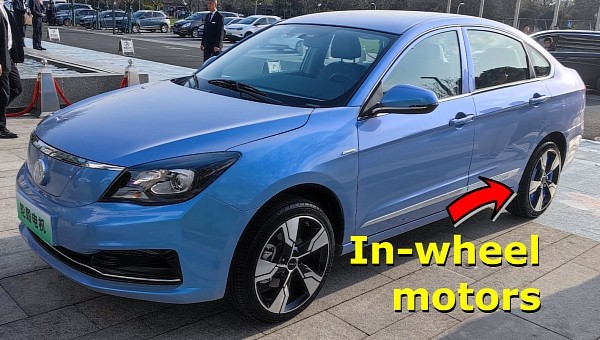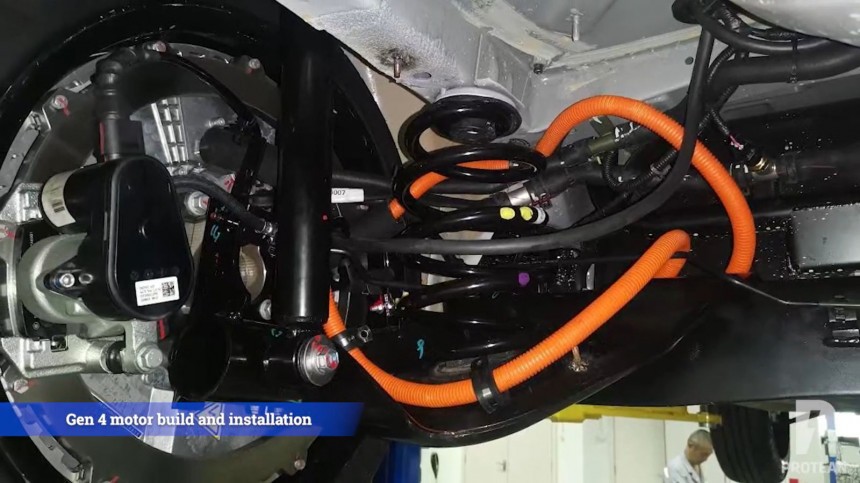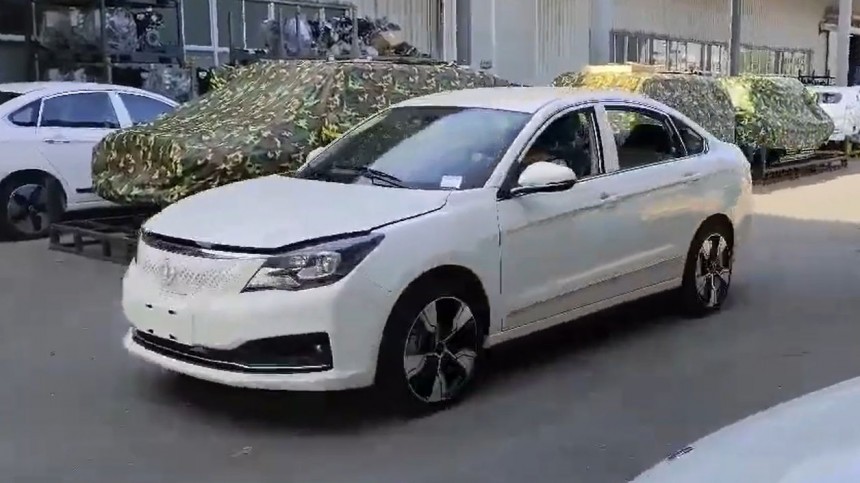British-founded company ProteanDrive partnered with Chinese car manufacturer Dongfeng Motor and Weifu Group to unveil not one, but two mass-production cars with in-wheel motors. Well, the “mass-production” part is simply a marketing stunt. But as it’s a “world’s first” headline, let’s see what’s all the fuss about.
In-wheel motors sound so logical. And it’s also a very old idea. For your information, Ferdinand Porsche – that’s right, it’s exactly the founder of Porsche whom we are talking about! – used this idea for the prototype Lohner-Porsche back in the 1900s.
It was the first gasoline-electric hybrid vehicle in the world, and it featured hub-mounted electric motors in each wheel. The electricity came from a battery, which was charged by a gasoline-engine generator. Of course, it was too sci-fi for the car industry from more than a century ago.
Still, the idea of in-wheel motors survived. And in the last twenty years, it started to evolve, thanks to electric vehicles’ rapid spreading. Today, in-wheel motors are very common for many electric bicycles or e-scooters. But they are nowhere to be seen in cars or trucks. I mean in mass-production large vehicles.
Why is that? There are several reasons. Having a motor directly into the wheel means there’s no gearbox or driveshaft. Wheel speed is equal to motor speed. So for a big torque, you need a big motor. And that leads to larger wheels and higher costs.
Then you have to consider that the in-wheel motor is directly exposed to dust and water, so it requires much better (and more expensive) insulation. Don’t forget it’s also subjected to vibration and shocks, so it's a matter of low reliability in the long term. Unless the in-wheel motor is built to be much more resistant, which again means very high costs.
As for handling, less unsprung weight is better, while lower inertia helps the shocks and springs keep the tires in contact with the road. In-wheel motors increase inertia, and the unsprung weight is higher, so tire-to-road contact is far worse, and the car is harder to accelerate/decelerate.
There are other issues the engineers could talk about for hours, but you get the picture. Now, keep in mind that engineers also like to overcome obstacles. You know that saying “for any problem, there is a cure.” ProteanDrive may have found it.
The British company was founded back in 2008, and in 2009, it used a Ford F-150 as a demonstration vehicle for its second generation of in-wheel motors. By the way, Ford tested the in-wheel motor technology for its new Ford F-150 Lightning Electric Truck but decided to ditch it because of too many disadvantages.
Throughout the years, ProteanDrive partnered with different Chinese companies for demonstration vehicle projects. More recently, the company fitted a Dongfeng E70 with its technology and, in December 2022, it allegedly became the world’s first homologated passenger car driven by in-wheel motors.
Now it’s time for some insights regarding the E70. It was launched back in 2011 as a Nissan Bluebird-derived petrol car and was named A60. It went through several facelifts and then, in 2019, the full-electric E70 variant emerged, with a low-performance ternary lithium battery.
In 2021, Dongfeng made an interesting move and used the E70 as a guinea pig. The carmaker built several cars fitted with new so-called semi-solid lithium metal batteries. The batteries were also swappable, like NIO’s electric cars.
But get this: in 2022, the company started a ride-hailing trial with 50 cars, and that was it. No more mass production for the E70 solid-state swappable battery until the trials end. And now, we get the exact same PR stunt all over again.
The ProteanDrive in-wheel technology is used for the rear wheels of this new demonstration variant of E70 to make it a 4WD car. Its front wheels are driven by a conventional electric motor, and this is the workhorse most of the time.
The companies emphasize that adding in-wheel motors makes for a lighter 4WD variant than classical solutions or even an e-axle one. Thus, this E70 is marketed as “a high-performing all-wheel drive” car, with an “acceleration time reduced by 42%.”
The in-wheel motors E70 is not for sale, because the first batch of demo cars is slated for fleet trials. So, sometime in the future, if the tests will be successful – and it’s a big if – we may hear again about this so-called “world’s first.” Just like the solid-state swappable battery “world’s first.”
Along with this E70, another car was showcased at the ceremony in Wuxi, but this one was just in a prototype phase. The Voyah Zhuiguang is a large luxury electric sedan, targeting the already popular NIO ET7.
I won’t say it’s a ‘Tesla killer,’ because it’s a bigger car than the Model 3. One could argue that the 200 in. (5 m) length and 188 in. (3 m) wheelbase rival Tesla Model S, but it’s priced at half. So, let’s not get into that comparison.
The normal car has a dual-motor all-wheel drive system, with a peak power of more than 500 hp and torque in excess of 500 lb. ft. (700 Nm). For some reason, ProteanDrive states that the car “is a new premium battery electric vehicle designed to use in-wheel motors.” No other details were made public about it, and this is kind of weird.
The bottom line is this “world’s first” is more like “China’s first,” because it was homologated solely by the China MIIT (Ministry of Industry and Information Technology). And we could even cut the “first” particle because these are just trial cars, not mass-production soon-to-be-sold-to-customers cars.
Despite the marketing stunt, it's just another step in the in-wheel motor technology development. Don’t hold your breath, as the real first mass-production cars to feature this tech are still some years away. I’d like to see them sooner on the roads, but I’m afraid at this point I’m simply realistic. Like most of the car industry when it comes to in-wheel motors feasibility.
It was the first gasoline-electric hybrid vehicle in the world, and it featured hub-mounted electric motors in each wheel. The electricity came from a battery, which was charged by a gasoline-engine generator. Of course, it was too sci-fi for the car industry from more than a century ago.
Still, the idea of in-wheel motors survived. And in the last twenty years, it started to evolve, thanks to electric vehicles’ rapid spreading. Today, in-wheel motors are very common for many electric bicycles or e-scooters. But they are nowhere to be seen in cars or trucks. I mean in mass-production large vehicles.
Then you have to consider that the in-wheel motor is directly exposed to dust and water, so it requires much better (and more expensive) insulation. Don’t forget it’s also subjected to vibration and shocks, so it's a matter of low reliability in the long term. Unless the in-wheel motor is built to be much more resistant, which again means very high costs.
As for handling, less unsprung weight is better, while lower inertia helps the shocks and springs keep the tires in contact with the road. In-wheel motors increase inertia, and the unsprung weight is higher, so tire-to-road contact is far worse, and the car is harder to accelerate/decelerate.
There are other issues the engineers could talk about for hours, but you get the picture. Now, keep in mind that engineers also like to overcome obstacles. You know that saying “for any problem, there is a cure.” ProteanDrive may have found it.
The British company was founded back in 2008, and in 2009, it used a Ford F-150 as a demonstration vehicle for its second generation of in-wheel motors. By the way, Ford tested the in-wheel motor technology for its new Ford F-150 Lightning Electric Truck but decided to ditch it because of too many disadvantages.
Throughout the years, ProteanDrive partnered with different Chinese companies for demonstration vehicle projects. More recently, the company fitted a Dongfeng E70 with its technology and, in December 2022, it allegedly became the world’s first homologated passenger car driven by in-wheel motors.
In 2021, Dongfeng made an interesting move and used the E70 as a guinea pig. The carmaker built several cars fitted with new so-called semi-solid lithium metal batteries. The batteries were also swappable, like NIO’s electric cars.
But get this: in 2022, the company started a ride-hailing trial with 50 cars, and that was it. No more mass production for the E70 solid-state swappable battery until the trials end. And now, we get the exact same PR stunt all over again.
The ProteanDrive in-wheel technology is used for the rear wheels of this new demonstration variant of E70 to make it a 4WD car. Its front wheels are driven by a conventional electric motor, and this is the workhorse most of the time.
The companies emphasize that adding in-wheel motors makes for a lighter 4WD variant than classical solutions or even an e-axle one. Thus, this E70 is marketed as “a high-performing all-wheel drive” car, with an “acceleration time reduced by 42%.”
The in-wheel motors E70 is not for sale, because the first batch of demo cars is slated for fleet trials. So, sometime in the future, if the tests will be successful – and it’s a big if – we may hear again about this so-called “world’s first.” Just like the solid-state swappable battery “world’s first.”
Along with this E70, another car was showcased at the ceremony in Wuxi, but this one was just in a prototype phase. The Voyah Zhuiguang is a large luxury electric sedan, targeting the already popular NIO ET7.
The normal car has a dual-motor all-wheel drive system, with a peak power of more than 500 hp and torque in excess of 500 lb. ft. (700 Nm). For some reason, ProteanDrive states that the car “is a new premium battery electric vehicle designed to use in-wheel motors.” No other details were made public about it, and this is kind of weird.
The bottom line is this “world’s first” is more like “China’s first,” because it was homologated solely by the China MIIT (Ministry of Industry and Information Technology). And we could even cut the “first” particle because these are just trial cars, not mass-production soon-to-be-sold-to-customers cars.
Despite the marketing stunt, it's just another step in the in-wheel motor technology development. Don’t hold your breath, as the real first mass-production cars to feature this tech are still some years away. I’d like to see them sooner on the roads, but I’m afraid at this point I’m simply realistic. Like most of the car industry when it comes to in-wheel motors feasibility.









